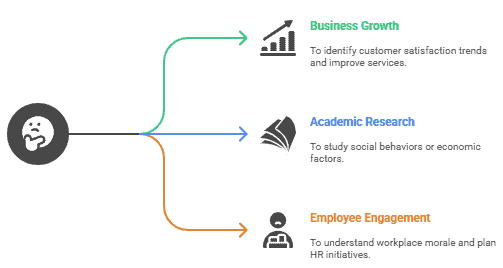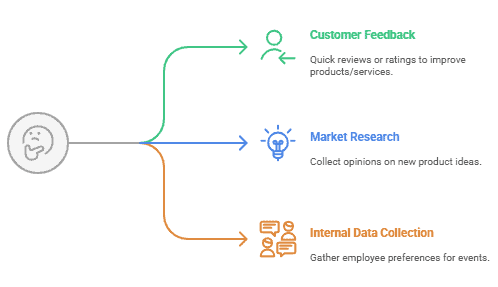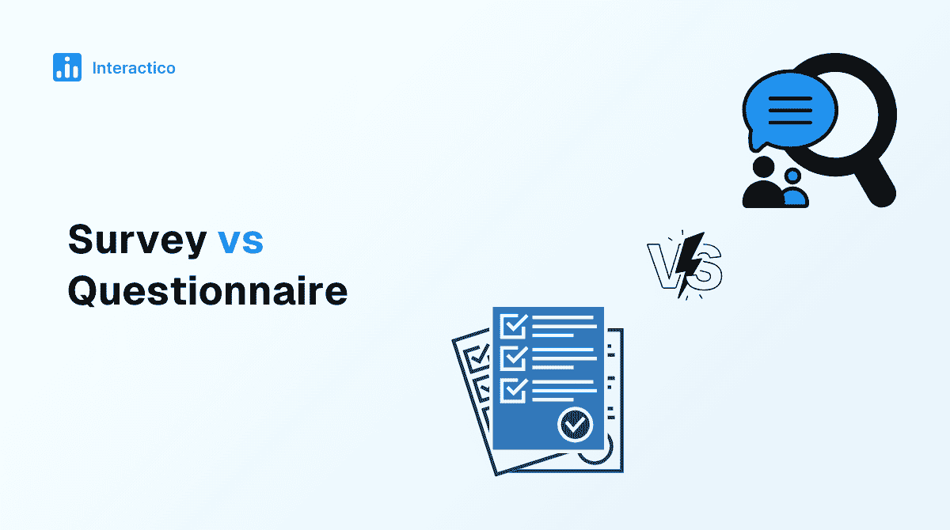Key Takeaways: Survey vs Questionnaire
- A survey is the complete process of collecting, analyzing, and interpreting data, while a questionnaire is just the set of questions used to gather responses.
- Surveys provide actionable insights through analysis, whereas questionnaires only provide raw data.
- Use a survey for business growth, academic research, or employee engagement. Use a questionnaire for quick feedback or simple data collection.
- Surveys require more time and methodology, while questionnaires are faster and easier to prepare.
- A questionnaire can exist on its own, but most surveys include questionnaires as part of the process.
Many people use the terms “survey” and “questionnaire” interchangeably, but in research, business, and feedback collection, they are not the same. Understanding the difference between a survey and a questionnaire can help you select the most appropriate method, improve your response rate, and gather more valuable insights.
This article provides a comprehensive examination of the topic of surveys vs questionnaires. It breaks down what surveys and questionnaires are, highlights their key differences, gives real-world examples, and helps you decide when to use what.
What is a Survey?
A survey means a broader process of collecting, analyzing, and interpreting data. While questionnaires are often part of surveys, surveys go beyond just asking questions.
- Scope: A survey includes designing the research, distributing the questionnaire, collecting responses, and analyzing results.
- Purpose: Surveys are used to make decisions, identify trends, or measure performance based on collected data.
- Methods: Can be online, telephone-based, face-to-face, or via mail.
- Example: A company wants to improve employee engagement. They design a survey that includes a questionnaire, distribute it via email, analyze the results, and then take action based on the findings.
So, a survey is the entire process, while a questionnaire is one component of it.
What is a Questionnaire?
A questionnaire means a structured set of written questions designed to collect information from individuals. It is essentially the tool or the instrument you can use to gather data, feedback, and research.
- Format: A questionnaire can be paper-based, digital, or embedded in an online form.
- Purpose: Its primary role is to collect information, opinions, facts, demographics, or preferences.
- Types of questions: Multiple-choice, rating scales, open-ended, yes/no, or ranking.
Example: A customer satisfaction form asking, “How satisfied are you with our service?” on a scale of 1-5 is a questionnaire.
In short, a questionnaire is a set of questions, but by itself, it doesn’t include the full research process.
What is the Difference Between a Survey and a Questionnaire?
Here’s a side-by-side comparison to make things clearer:
| Aspect | Survey | Questionnaire |
|---|---|---|
| Definition | The overall process of data collection & analysis | A set of structured questions |
| Purpose | Collect, analyze, and interpret data | Collect raw data |
| Scope | Broader: includes methodology, sampling, analysis | Limited to questions |
| Time | Requires more time to design, conduct, and analyze | Quick to prepare and distribute |
| Example | Customer satisfaction survey project | Customer feedback form |
| Questions | May include open-ended and closed-ended questions for deeper insights | Mostly, closed-ended, simple, and structured questions |
| Answers | Provides qualitative and quantitative data for analysis | Provides raw, unprocessed responses |
| Outcome | Actionable insights | Data points |
| Methodology | Involves planning, designing, sampling, distribution, and analysis | Focuses only on designing and presenting questions |
When to Use a Survey
Use a survey when you want to go beyond raw data and get actionable insights.

- Business Growth: Identifying customer satisfaction trends and improving services.
- Academic Research: Studying social behaviors or economic factors.
- Employee Engagement: Understanding workplace morale and planning HR initiatives. Employee engagement surveys help organizations gauge how employees feel about their work, team, and workplace
Why Use it: Surveys provide a structured process that turns responses into meaningful decisions.
When to Use a Questionnaire
A questionnaire works best when you simply want to collect information without necessarily conducting an in-depth study.

- Customer Feedback: Quick product reviews or service ratings. Check out these customer feedback questions to design better questionnaires.
- Market Research: Collecting opinions on a new product idea.
- Internal Data Collection: Gathering employee preferences for an event.
Why Use it: Questionnaires are easy to create, distribute, and analyze for quick insights.
Common Misconceptions: Survey Versus Questionnaire
- They are the Same Thing: Not true. A questionnaire is a tool. A survey is the process.
- Surveys Always Include Questionnaires: Many do, but some surveys involve interviews, observations, or focus groups instead.
- Questionnaire Guarantee Insights: A questionnaire alone only gives you raw data. Analysis is needed to gain insights.
Best Practices for Using Surveys and Questionnaires
Surveys work best when they are clear, simple, and easy to answer. The following smart moves can help you get honest feedback and results you can actually use.
- Keep it short and relevant. Long forms reduce response rates.
- Ask clear and unbiased questions. Avoid leading or confusing wording.
- Choose the right format. You can opt for an online survey for a wider reach, a paper survey for specific groups, and an in-person survey for detailed answers.
- Test before sending. Pilot with a small group to identify issues.
- Analyze thoroughly, especially for surveys, where insights depend on interpretation.
Real-World Example: Difference Between Survey and Questionnaire
Let’s say an e-commerce company wants to improve its return policy:
- They start with a questionnaire asking, “How easy was it to return a product?”
- Next, they conduct a survey using this questionnaire, collect responses from 500 customers, and analyze patterns.
- Findings reveal that 60% found the return process confusing. The company uses this insight to simplify return steps.
Create surveys fast with Interactico. Design, share, and analyze feedback effortlessly. Start now!



